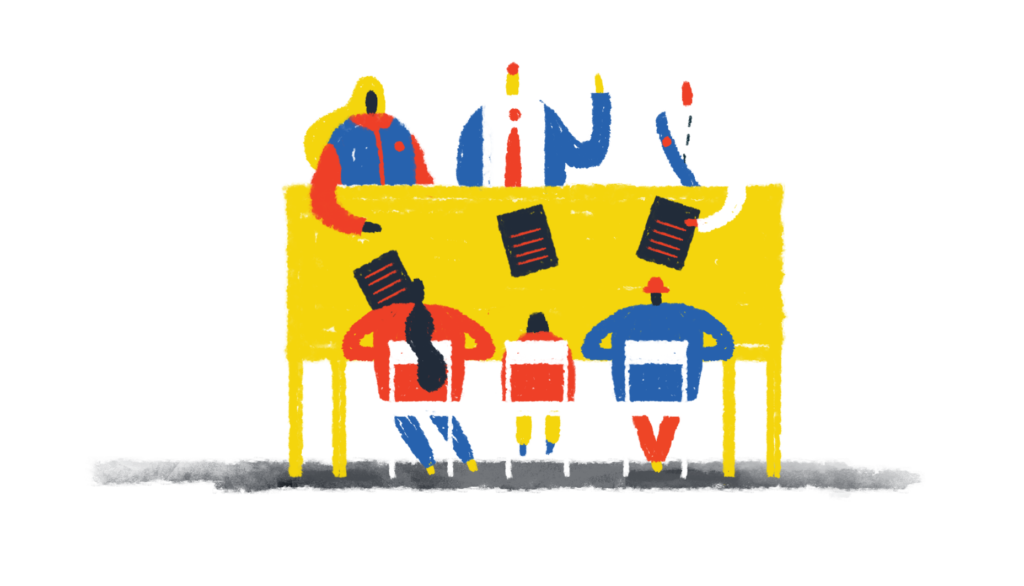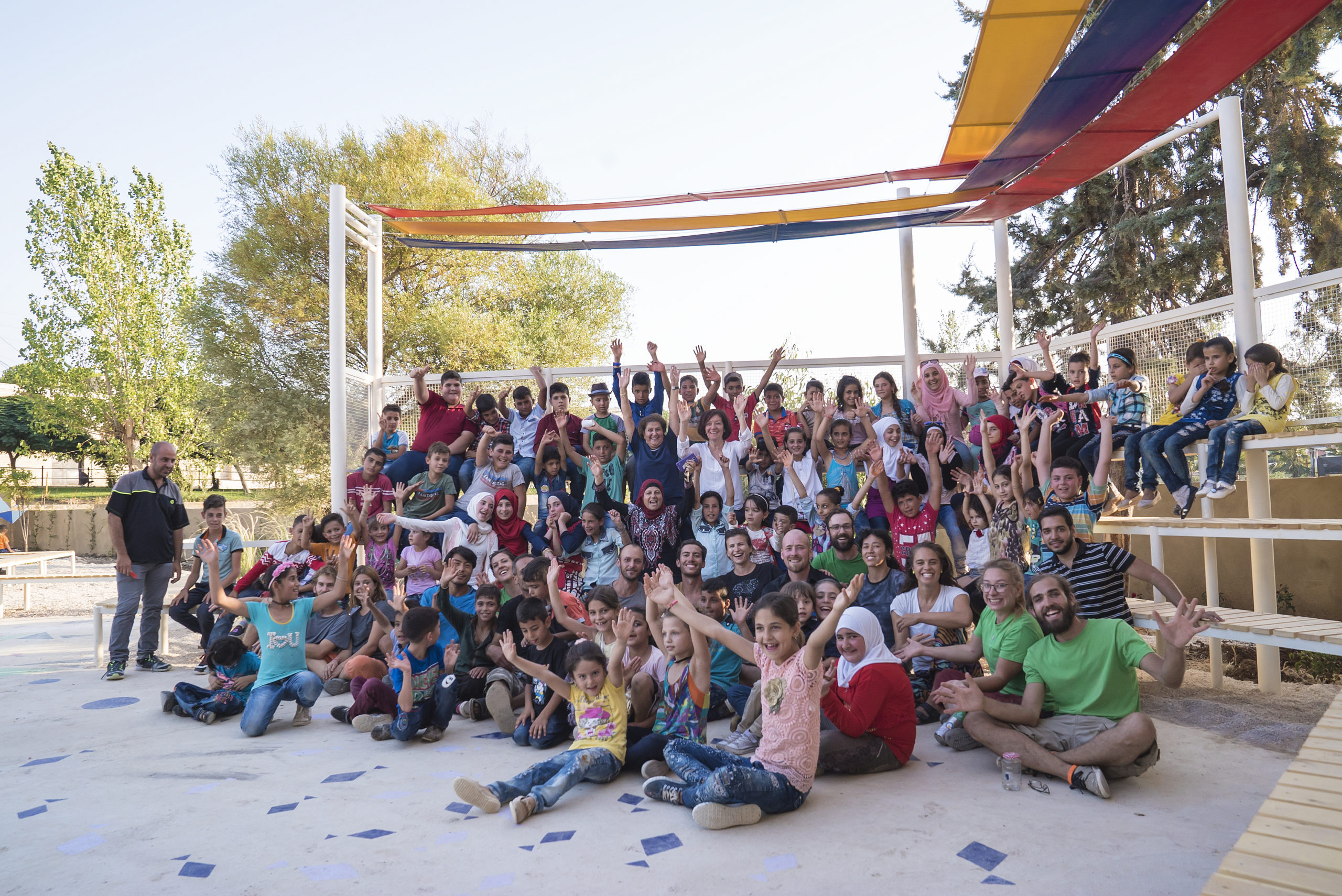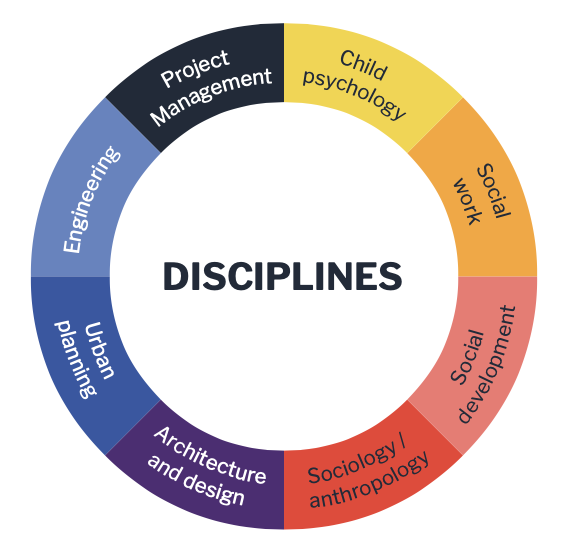
Key points
Children and their communities must be considered partners in the intervention.
As co-designed built interventions require different functions, roles and capacities, complementary actors need to form partnerships.
The expertise required draws upon very different disciplines that should find a common language.
Discussing at length, and clarifying in writing, the objectives, roles and contributions of each actor supports successful delivery.
Co-designed built interventions with children are complex and require carefully crafted partnerships. It is unlikely that a single actor can provide all the roles, functions and skills required for a successful intervention.

Actors take on different functions, roles and capacities depending on the context (see some examples in the table below). Therefore, a context- specific division of roles amongst partners is suggested. For instance, the powers, capacity, resources, political will and relationship with residents of national, municipal and local governments will vary enormously between and within countries.
Partnerships require complementarity. To foster commitment and a sense of ownership, interventions should uphold the objectives of each party. A good partnership is one where all parties can contribute something important to the intervention. The table below presents some examples of actors, what they add to the intervention, and their motivations.
ACTORS
WHAT THEY ADD TO THE INTERVENTION
WHAT THEIR MOTIVATIONS ARE FOR THE INTERVENTIONS
Community
Children and their caregivers
Knowledge of their community, individual and collective needs and visions, different skills, legitimacy, creative energy, desire to participate, motivate other actors
Improving their community, benefiting from the intervention, learning new skills, having fun and positive play experiences, sharing ideas, being heard, engaging with other children or residents who they may not otherwise.
Other local residents
Knowledge of their community, individual and collective needs and visions, skills, resources, their participation (often some groups are prioritised, e.g. women, youths, older persons, persons with disabilities).
Improving their community, benefiting from the intervention, learning new skills, understanding the needs, situations and perspectives of other members of the community.
Community-based organisations (including youth groups, scout groups, etc)
Knowledge of their community, a group of organised people who know each other, representation of collective interests
Improving their community, promoting their objectives
Community leaders
Knowledge of their community, representation of collective interests
Improving their community, recognition of their role
Local schools or children centres
Knowledge of the children, capacity to reach children and their families, expertise in working with children, space for the intervention, resources (human, financial)
Improving the school environment and learning, benefiting the children
Healthcare centres, clinics, dispensaries and hospital doctors and staff
Knowledge of the community, space for the intervention, resources, needs and visions
Improving the community, benefiting the children
Universities
Funding, human resources, legitimacy, technical knowledge, documenting the process
Conducting research, delivering impact through research
Volunteers
Funding, expertise, skills, labour
Improving community, personal interests, learning new skills, career development
Government
Local government (municipality or specific departments, officers)
Political will, provide/obtain data on the area, outreach into communities, building/planning permits, technical knowledge, project management, maintenance
Improving the lives of their citizens, visibility, fulfilling their mission, agenda
National government (relevant ministries)
Political will, legitimacy, funding, replicability and scaling- up potential
Building local capacity, innovating, visibility, achieving their objectives
Non-profit organisations
Local NGOs
Knowledge of local context and community, specific skills, human resources
Implementing their programmes, promoting their objectives, benefiting local children and residents
International NGOs
Expertise not available locally, funding, project management, experience from other contexts
Expanding their impact, building local capacity, achieving their mission
Multilateral organisations
Endorsement, funding, legitimacy, expertise
Achieving their mission, building local capacity, visibility
Private Sector
Local contractors
Building expertise, knowledge of local materials and building practices, legitimacy
Livelihood, profit, contributing to community improvement
Providers
Goods and services, including building materials, skills
Profit, visibility, Corporate Social Responsibility
Private institutions or companies
Funding, pro-bono services (e.g. engineering), expertise, visibility
Visibility, Corporate Social Responsibility
This handbook often refers to organisations as the main actors in the process. However, initiatives emerge from specific people within organisations and communities who champion ideas and ensure that they are translated into action. Therefore, while the handbook discusses partnerships between organisations, in order to be successful, they require supportive people within each.
While different combinations of the above actors are possible in an intervention, below are the required functions in co-designed built interventions. Some of these roles may be played by the same actor and can vary in different contexts and interventions. An open discussion about the role of each partner, recognising each other’s expertise and gaps, can help allocate resources and time appropriately to support effective collaboration.
FUNCTION
EXAMPLE OF KNOWLEDGE/SKILL
EXAMPLE OF ACTORS
Develop the idea
Knowledge of the context, local/national and global framework, creativity
Children, caregivers, residents, built environment professionals, funders, INGOs, government institutions
Form partnerships
Coordination, knowledge of actors and their roles
Funders, INGOs, NGOs, local authorities, built environment professionals, children, caregivers, residents
Draft the objectives of the partnership & roles
Knowledge of regulations, roles and responsibilities, organisational skills
Funders, INGOs, NGOs, local authorities
Research local context, or build information data base
Research and analysis, knowledge of the context
Researchers, children, caregivers, facilitators, residents, key stakeholders
Prepare for participatory activities
Coordination, knowledge of the local community, ethical protocols and child protection policies, participatory tools
Facilitators, children, caregivers, users of the space, educators, field officers, NGOs, municipalities, schools, clubs
Identify and understand local needs
Knowledge of local community, user engagement, understanding of the context, participatory research tools, communication and facilitation
Children, caregivers, users of the space, educators, facilitators, field officers, neighbourhood committees
Conduct participatory design activities
Design thinking, spatial design, participatory design tools, socio-cultural practices, engaging children, communication, facilitation
Children, caregivers, users of the space, facilitators, built environment professionals, NGOs, volunteers
Produce a preliminary design
Analysis of input from participation, design visualisation, communication
Built environment professionals, children, caregivers, users of the space, local government, NGOs
Obtain building permits
Local building regulations, safety measures
Built environment professionals, local government
Develop the final design
Spatial design, child friendly design, characteristics of the intervention site, visualization
Built environment professionals, local government, users of the space
Draft the technical design
Knowledge of local materials and building skills, technical design
Built environment professionals, contractors
Procurement and management
Knowledge of procurement policy, management
Built environment professionals, contractors, residents
Build
Knowledge of building construction, management, coordination, health and safety measures, supervision
Contractors, built environment professionals, builders, labour, caregivers, children (through structured safe activities), volunteers
Activate the intervention
Coordination, communication, knowledge of local community, user engagement
Children, facilitators, volunteers, CBOs, caregivers, users of the space, local government, NGOs
Monitor the use of the intervention
Knowledge of the intervention, user engagement, knowledge of the context
Local government, NGOs, built environment professionals, caregivers, users of the space, children
Perform maintenance
Knowledge of the technical design, building techniques, building materials
Local government, NGOs, contractor, builders, built environment professionals, users of the space
Long-term community management
Knowledge of users and relationships with other institutions, capacity to develop and adapt the space to users’ needs
Community organisations, municipalities
Conduct impact evaluation
Knowledge of evaluation process, of the intervention (process and product), qualitative and quantitative data collection
Children, facilitator, external consultant, users of the space, caregivers, built environment professionals
Built interventions co-designed with children affected by displacement require a wide range of disciplines. It may not always be possible to have them all involved, and the nature of the intervention determines their relative importance. The diagram below shows some of the most important.
Diagram 5
Transdisciplinarity




